FAQ on mandatory labeling of shoes: Everything that you did not know and were afraid to ask
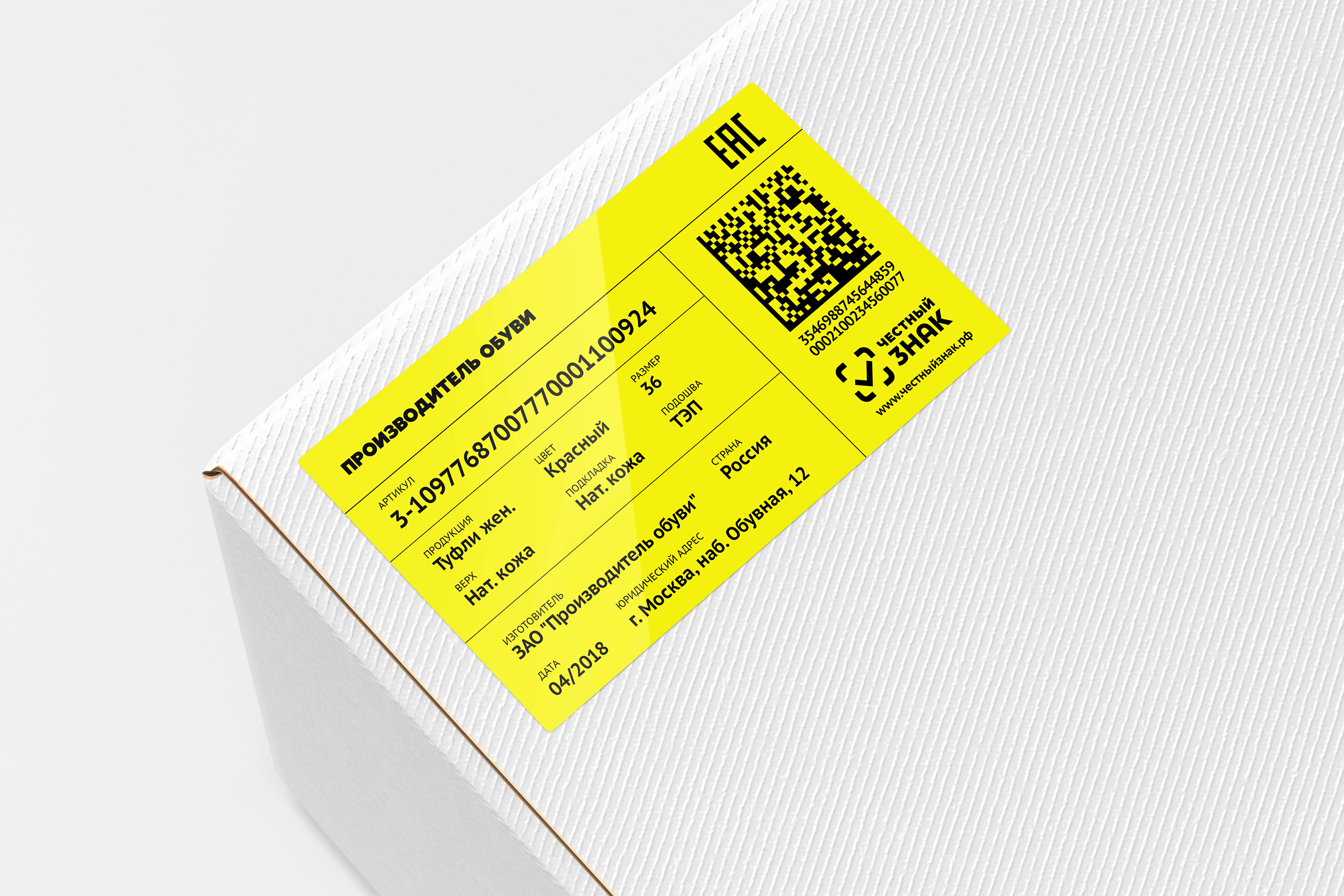
We have collected the most popular questions on mandatory labeling of goods and tried to answer them.
When does mandatory shoe marking start?
Mandatory shoe marking starts on July 1, 2019.
After July 1, 2019, only marked shoes will be sold?
To answer this question, let's look at the timing and stages of labeling shoes. From July 1 to October 1, 2019, all participants in the shoe market will have to register in the Honest Sign information system (for all participants - get a private key and certificate), manufacturers and importers - form applications for access to equipment for registering the issue of brands.
From October 1, 2019 to February 1, 2020, manufacturers, importers should receive equipment (emission registrars), and all participants in the chain should mark their leftover shoes. Starting February 1, 2020, it will be prohibited to sell unmarked shoes.
Who will be affected by the labeling?
Manufacturers, traders and distributors of shoes. The latter - because on the territory of the Russian Federation shoes made abroad should be already marked (even before crossing the customs). Since not all small foreign footwear manufacturers will be ready to immediately comply with labeling requirements, at first distributors (importers) will take this responsibility.
Will shoe marking be canceled?
Absolutely not. Moreover, by 2024 it is planned that only labeled goods will be sold in Russia.
What shoes should be labeled?
It’s clear that the matter is dark. There is no specific list of goods, only the list is provided according to OKPD2 (15.20.11, 15.20.12, 15.20.13, 15.20.14, 15.20.21, 15.20.29, 15.20.31, 15.20.32, 32.30.12) and TN FEA (6401, 6402, 6403, 6404, 6405).
But ski boots have to be marked?
Well, where without them? Code 32.30.12.
Who is responsible for organizing the labeling of shoes?
The project is supervised and controlled by the operator of the Center for the Development of Advanced Technologies (CRTC), the Ministry of Finance, Digital Development, Industry and Trade, the Tax, Rospotrebnadzor, the Federal Customs Service and the Federal Security Service.
Why were DataMatrix codes chosen for shoe marking?
Compared to the same RFID tags, DataMatrix codes are much cheaper. They can be recognized even with partial damage. DataMatrix codes store a large amount of information, but at the same time they take up little space on the package.
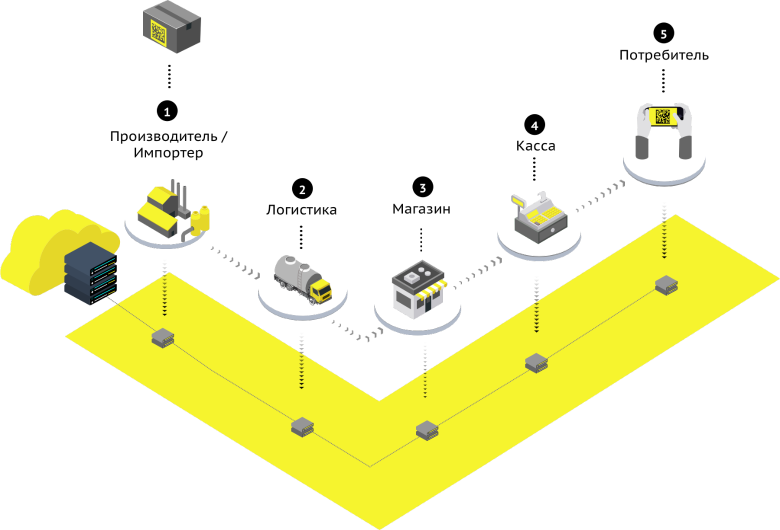
What does DataMatrix code consist of?
The DataMatrix code consists of:
- an identification code that determines the position of the product in the marking system of a single catalog of goods (GTIN, which is issued by GS1);
- an individual serial number and a crypto tail that protects against fakes. It is generated by a special system operator, which must be installed for each legal entity;
- product recognizer - the first 4 characters of the code of the Commodity Nomenclature for Foreign Economic Activity of the Eurasian Economic Union. With its help, the system learns which particular product was marked;
- “electronic signature” used to control the disposal of goods during sales using the online cash desk - 31 characters will be printed on the label. If there are problems with reading at the checkout, the seller can enter it manually.
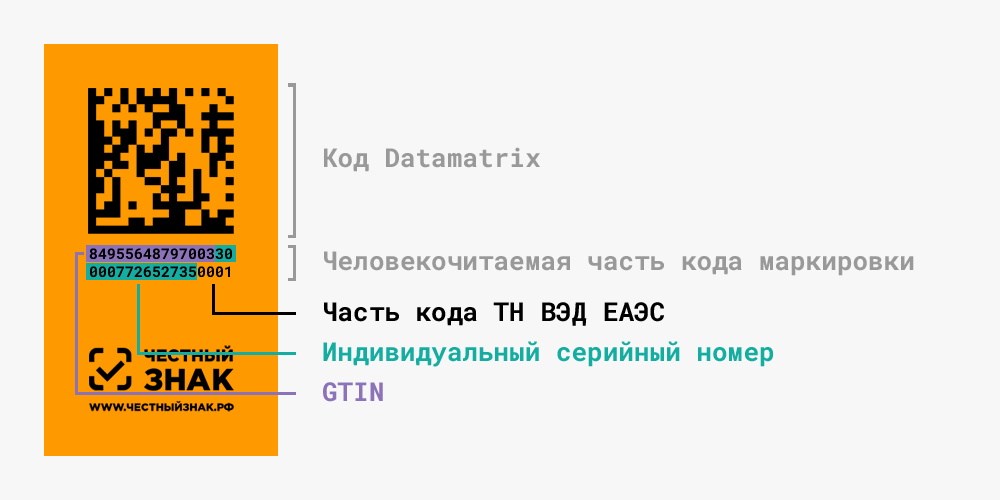
How is the labeling and tracking process going?
- The shoe manufacturer sends a request for the creation of an identifier to the CRTC operator;
- It generates a unique crypto-protected code and passes it to the manufacturer;
- the manufacturer prints this code in the form of DataMatrix and applies it to the packaging of shoes;
- when importing a product, selling it, moving it, or even writing it off, the DataMatrix code is scanned;
- all this information is accumulated in the information center of the MDCT;
- codes are withdrawn from circulation after the shoes are sold to final consumers.
Can stamps be reused?
Each product must be labeled, and the brand is unique. It can be printed and used only once (with the exception of the return of goods by the buyer).
What happens if the buyer returns the goods?
If the buyer returns the goods, the seller will have to re-mark it on their own if the brand is damaged. Only after that the shoes will return to circulation.
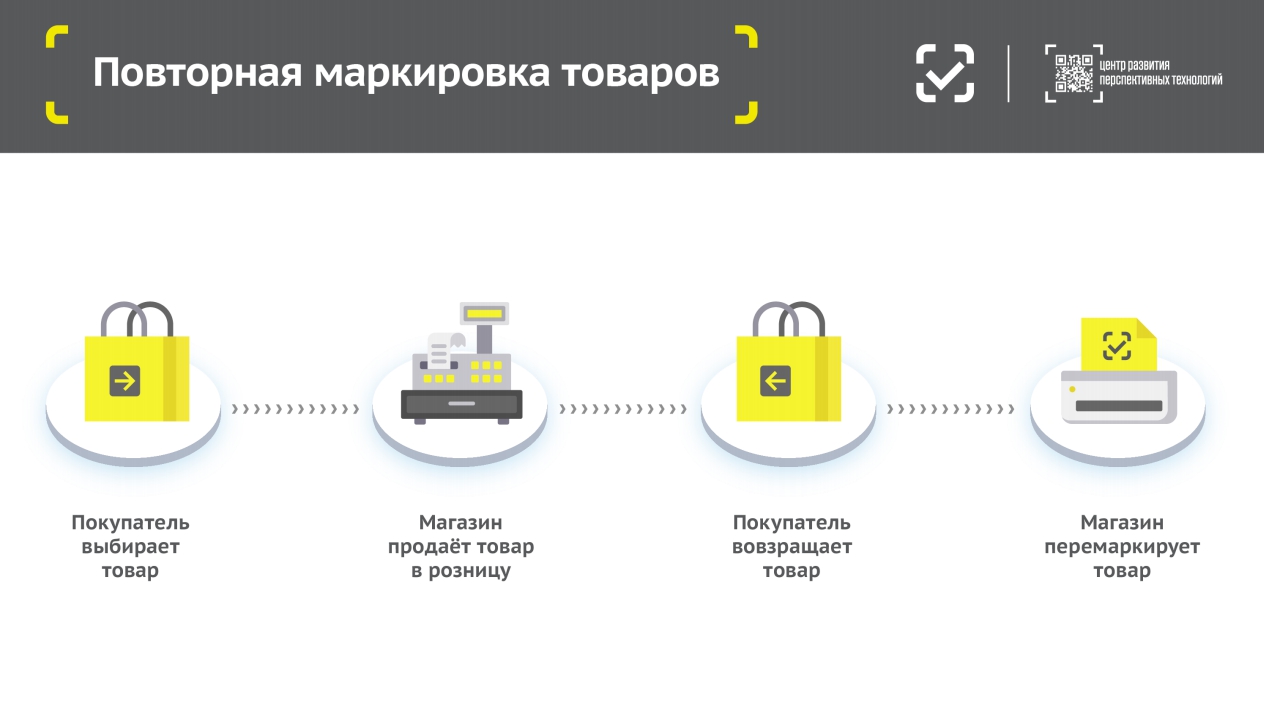
How to remove the shoes that the company bought for itself?
If the company acquires safety shoes without the purpose of reselling them later, then it needs to familiarize themselves with paragraphs 65 and 66 of the “Methodological recommendations for participants in the experiment on labeling with identification and monitoring tools for shoe products that comply with the EAEU 6401-6405 HS codes in the Russian Federation” and send in the labeling system the data indicated in them.
What to do with residues when marking shoes?
Residues must be marked before February 1, 2020. Moreover, from October 1, 2019 to February 1, 2020, balances can be marked with simplified codes. The CRTC website says that retailers will have to sell such shoes within two years from the date the products are put into circulation.
Simplified company codes can be obtained from July 1 to October 1, 2019. To do this, you do not need a registrar of emissions - you can get them in your account in the system itself. As soon as the manufacturer receives the registrar of emissions, he will have to use it to label the goods.
Will the law on shoe labeling also affect the markets?
And the markets too. In accordance with paragraph 62 of the methodological recommendations mentioned in the previous answer, they need to transfer data to the marking system within 3 days from the date of sale. How exactly - is still unknown, lawmakers are only considering this issue.
Will buyers have to do something too?
If you just bought yourself, for example, sneakers, then no. The marking code was written off at the time of the sale at the checkout. But if you plan to resell this pair in the future, then you automatically fall under the labeling law, and formally you need to mark the sneakers and put them into circulation. Another thing is whether it will succeed. Initially, it was planned to create centers for labeling and labeling, which could be contacted by small retailers who do not have their own facilities and equipment for labeling goods. However, later it became clear that the services of such companies would be quite expensive. Therefore, whether such centers will be created or not is still unknown.
What happens if you produce or sell unmarked shoes?
Punishment for violations of the production and sale of unmarked shoes is regulated by Art. 15.12 Administrative Code of the Russian Federation.
For the production of unmarked shoes, officials will receive a fine of 5 to 10 thousand rubles, legal entities - from 50 to 100 thousand rubles. In both cases with confiscation of the violation.
For the sale of unmarked shoes, their transportation and storage, the individual entrepreneur receives a fine of 2 to 4 thousand rubles, officials - from 5 to 10 thousand rubles, legal entities - from 50 to 300 thousand rubles. In all cases, shoes are confiscated.
If we are talking about a major violation - the cost of the entire batch exceeds 1.5 million rubles (in accordance with Article 169 of the Criminal Code of the Russian Federation large or especially large amounts), then criminal liability arises under Art. 171.1 of the Criminal Code.
How to prepare shoe stores for labeling?
First, register in the Honest Sign information system. Secondly, make sure in advance that cash register software and trading equipment can work with DataMatrix codes. And if necessary, replace devices (for example, one-dimensional barcode scanners with two-dimensional ones), buy the missing ones (for example, label printers for marking goods, data collection terminals with software for storage and goods reception) and install software for creating and printing labels (we recommend BarTender ) As our practice has shown, this is also not the easiest stage, since not all scanners read DataMatrix correctly.
If we talk more about cash register software, its modernization is necessary for the software to learn how to perceive DataMatrix codes and send read data to the CCP, which, in turn, will send them to the OFD and write it to the fiscal drive. For example, we have already completed these works, and the Profi-T cash register software meets the requirements for compulsory labeling of goods.
Are scanners really that bad?
As the Levada-Center study showed , 38% of stores are equipped with 2D scanners, 17% use one-dimensional ones. In 41% of stores, no scanners are used at all.
A survey of shoe market participants by Pilot experts showed that 66.7% of respondents did not have ready-made equipment for the start of shoe marking. Most of the respondents (including retailers and distributors) reported the need to replace one-dimensional with two-dimensional scanners.
What other costs will be needed?
At a minimum, consumables will also be required (the same labels for printers):
- only the thermal transfer type of printing providing long-term storage of the label is suitable for marking;
- type of media: self-adhesive paper or film, paper labels, tape, tags;
- additional ribbon for printing.
According to our estimates, for 10,000 pairs of shoes, it will be necessary to buy consumables of about 6,000 rubles, which will naturally affect the final price of shoes for buyers.
What labeling features are there for manufacturers and importers of shoes?
Manufacturers and importers of shoes will need to get a GTIN for each supplied model.
How long does it take to place an order for stamps from the personal account of the CRPT?
Take for example a small company that produces about 500 pairs of shoes per day (each one needs a separate GTIN). To place an order to receive marks for 500 GTIN in your personal account of the MDCT, you will need 2 employees. They will be engaged in this process throughout the working day (8 hours), while they will not have time even for lunch and the right to make mistakes. Agree, this is unrealistic and violates the Labor Code of the Russian Federation.
With each issue of the seasonal collection, the ordering operation of the stamps is repeated. Therefore, the decision to automate the process seems reasonable, but not everyone can do it. For example, we at Pilot developed a utility for manufacturers of Easy Label(to automate the process of receiving stamps from the personal account of the CRPT and converting them into the corporate format for label printing) and the “Marking Server” (created to carry out piece-by-piece accounting (separately from ERP) of marked goods).
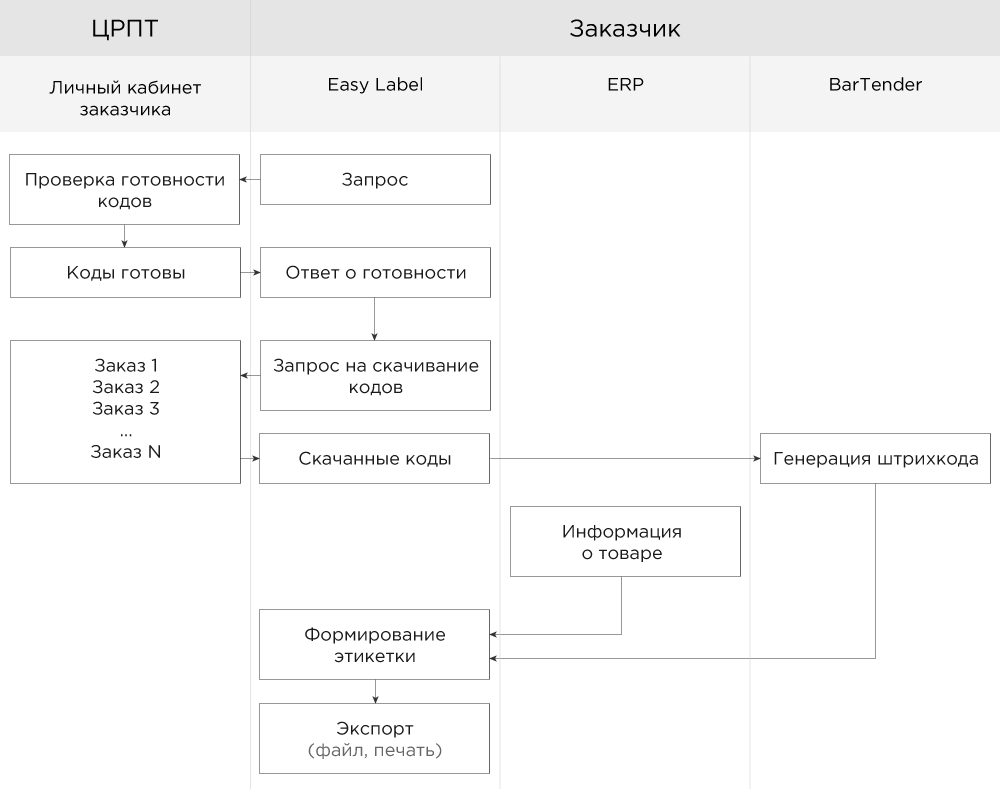
Is uploading data as difficult?
Yes, if you work without automation, each file from the central distribution center with stamp orders must be manually downloaded. And then create a corporate-style label and print it.
How to transfer data to manufacturers?
If the retailer orders goods from a foreign manufacturer, then he needs to receive codes in his personal account, to form labels from them in a corporate style and electronically send them to production.
Why do you need a piece of shoe accounting and what to do with it?
Manufacturers, distributors and retailers have information systems responsible for production, storage and logistics that keep track of goods by article and quantity. However, they do not take into account movement for a specific unit of goods. However, the introduction of marking implies just the appearance of single-entry accounting, since products are marked with unique codes. Therefore, there is a need to change business processes in the context of accounting for each pair of shoes. Typically, a retailer has several information systems. Therefore, he has two ways: either to modernize each of them to implement piece-keeping accounting, or to create another system from scratch and integrate with it to meet the marking requirements. For Pilot, the Marking Server acts as such a system.
Want to learn more about shoe labeling?
Pilot invites you to participate in a free webinar on mandatory labeling of shoes. It will be held on May 22 at 11:00. You can register for the webinar here .
Within an hour, our speaker - Evgeny Yaitsky, head of the sales department for corporate customers and partners of the Pilot company - will talk about general rules and terms for marking goods, features for marking shoes, solutions for retailers and wholesalers, importers and manufacturers.
He will also advise on what to look for when choosing label printers and barcode scanners, share the cases of Pilot customers, announce a step-by-step action plan for retail, importer and manufacturer, and, of course, answer questions from webinar participants.
All registered participants of the webinar will receive a free PDF brochure “How to Russian business comply with the rules for marking shoes” and a speaker’s presentation.
If you want to know more, we voiced the reaction of market players here , and gave recommendations on equipment here .
